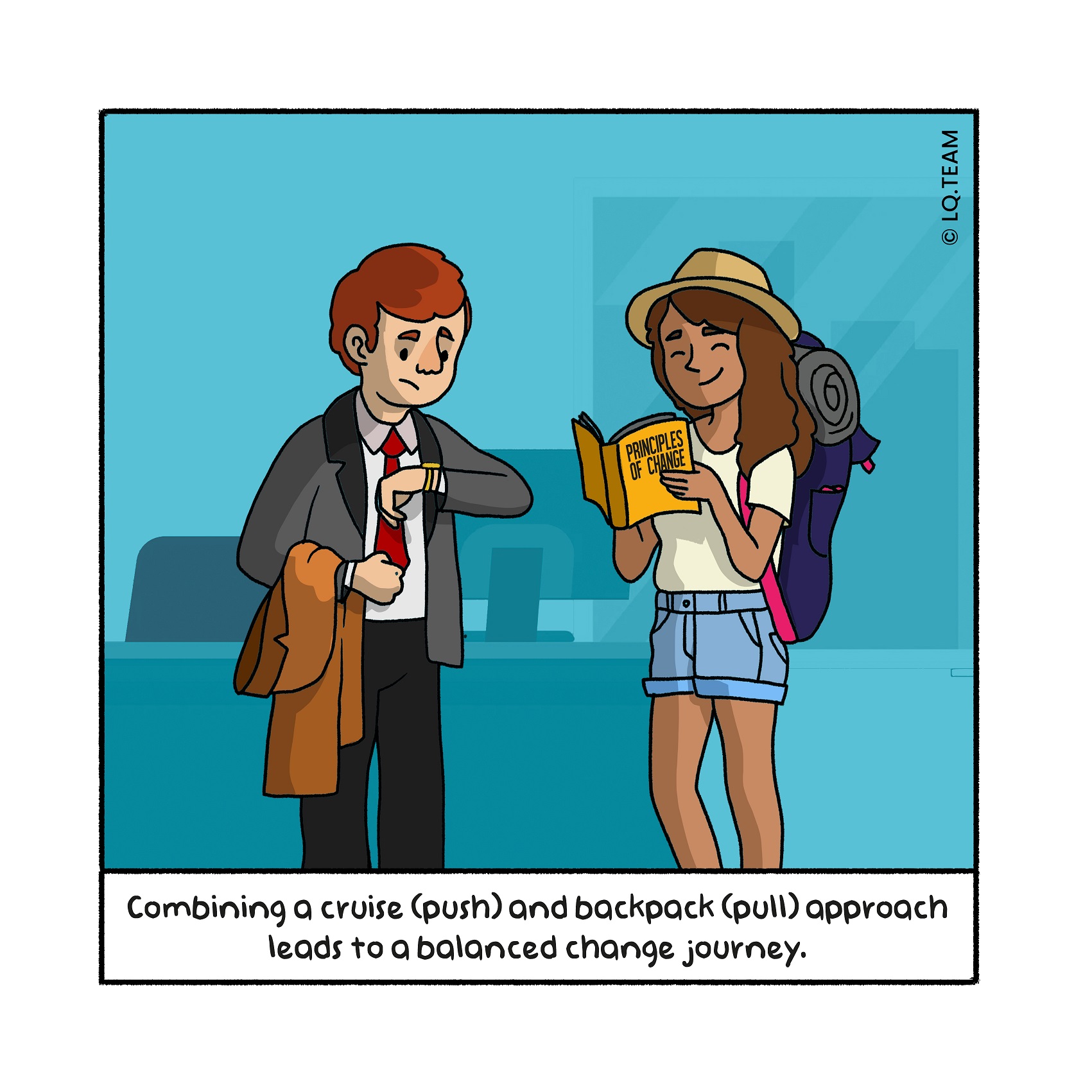
Nut to crack: Go for a push or pull change approach?
Do you manage your transformation top-down or bottom-up? And if it is true that people want to change but don’t want to be changed, when do you consciously choose an imposed change route, and when don’t you? What approach works best in which situation? These questions come up in almost every process and are not always easy to answer.
Nutcracker: Cruise with backpack
Managing top-down change differs from “enforcing” or “imposing” top-down change. When choosing top-down, you can opt for both a push approach and a pull approach. But rather than calling the approaches push and pull, I find the metaphor of going on a cruise and backpacking useful to illustrate the type of journey. A cruise has clear timelines, milestones and a well-defined character, with a clear start and end point. The approach feels a bit strict- er and is often experienced as a push. A cruise approach works well when changing more rational matters such as organisational structure, process- es and systems. A backpack approach symbolises a more flexible, organic journey in which principles and objectives are presented, but people direct their change process. This approach is often experienced more as a pull. A backpack approach typically helps change behaviour and ways of working. Running these two approaches simultaneously gives people space to explore while offering guidance by setting boundaries. The following support tool describes the cruise and backpack methods in detail. The real-life example shows how to put this dual approach into practice.
Real-life example: The fastest route
An organisation known for its clothing for the fashionconscious consumer wants to transform from a traditional to a circular organisation in five years. The company’s two directors need to agree on how to get there, but they have seemingly opposing view points.
One believes in a centrally managed, strict change approach because it would go faster. The other believes in the pace of an organic process because it generates a ripple effect. After much discussion and conversation, the directors conclude that one approach can not exist without the other. Establishing and anchoring the sustainability strategy in the organisational structure requires an organised process. This is designed and managed centrally and has a clear start and end date: a cruise. The result is a formulated objective at the heart of the corporate strategy, aiming for zero waste and creating a sustainability executive director role, reporting to a sustainability impact board. This impact board comprises directors from each discipline accountable for executing the sustainability strategy. To change beliefs, behaviour and working methods, a flexible route is chosen: backpacking. In working sessions, large groups of managers and employees are en couraged to clarify how they can redesign their daily work in line with the zerowaste ambitions. The combination of the cruise and backpack approach leads to a balanced change journey, in which cocreation with employees in the organisation takes place within clear frameworks of corporate strategy and organisational structure.
Tip for change leader
Depending on your profile, you may feel more comfortable with a cruise or backpack oriented approach. Rationally minded leaders often choose the cruise approach, while more creatively minded leaders choose the backpack approach. However, one cannot exist without the other. Therefore, ensure you gather people with complementary styles in your team to strike a good balance in your change journey.
Tip for change enabler
The backpack method is organic in nature, but that does not mean that it comes without obligation or accountability. If this approach is chosen, ensure that progress is made transparent. Pulse surveys can help with this – see Challenge 45 for more information.
Kernel: A dual strategy is often necessary
Depending on the organisation development dial you need to turn, a cruise or backpack-oriented approach will be more suitable. In many projects, you tune several dials simultaneously. This requires a dual change strategy in which you are comfortable applying both.
